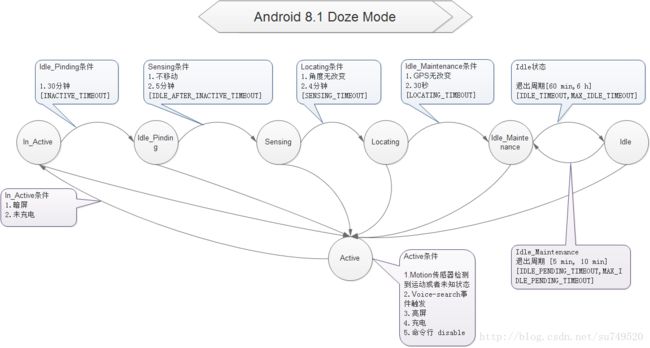概述
Android 6.0引入的Doze机制在于节省系统耗电量,保护电池,延长电池的使用时间。当设备未连接至电源,且长时间处于闲置状态时,系统会将应用进入Doze,置于App Standby模式。而最终的效果,能提升30%的电量续航能力。
Doze模式的状态
该状态与API版本无关,未适配API23以上的应用只要运行在6.0以上的系统上就会受到Doze模式的影响。
- 在屏幕熄灭30分钟、没有晃动并且在不充电的时候,会进入Doze模式
- 在进入Doze模式后,每间隔一段时间,会进入一段时长为30s的
maintenance window的窗口期,可以唤醒系统,进行网络交互等等 - 进入Doze模式后,如果没有退出的话,系统唤醒的间隔时长会越来越长
当系统处于Doze模式下,系统和白名单之外的应用将受到以下限制:
- 无法访问网络
- Wake Locks被忽略
- AlarmManager闹铃会被推迟到下一个maintenance window响应
- 使用
setAndAllowWhileIdle或SetExactAndAllowWhileIdle设置闹铃的闹钟则不会受到Doze模式的影响 -
setAlarmClock设置的闹铃在Doze模式下仍然生效,但系统会在闹铃生效前退出Doze
- 使用
- 系统不执行Wi-Fi/GPS扫描;
- 系统不允许同步适配器运行;
- 系统不允许JobScheduler运行;
而位于白名单中的应用可以:
- 继续使用网络并保留部分wake lock
- Job和同步仍然会被推迟
- 常规的AlarmManager闹铃也不会被触发
应用申请加入白名单
App可以通过PowerManager.isIgnoringBatteryOptimizations检查本App是否在系统的白名单列表中。
如果不在,则可以通过在AndroidManifest.xml中添加REQUEST_IGNORE_BATTERY_OPTIMIZATIONS权限,并且通过发送ACTION_IGNORE_BATTERY_OPTIMIZATION_SETTINGS的Intent来向用户申请该权限
原理
Doze的原理是在框架层对资源加入了一层资源的调度。在监听系统硬件或者屏幕亮暗的中断信号所发出来的广播,然后对于JobScheduler以及AlarmManager中任务进行统一调度。
而Doze的源码在于链接:
/frameworks/base/services/core/java/com/android/server/DeviceIdleController.java
在DeviceIdleController中存在一个mState变量来保存当前设备的状态,状态值如下:
/** Device is currently active. */
private static final int STATE_ACTIVE = 0;
/** Device is inactve (screen off, no motion) and we are waiting to for idle. */
private static final int STATE_INACTIVE = 1;
/** Device is past the initial inactive period, and waiting for the next idle period. */
private static final int STATE_IDLE_PENDING = 2;
/** Device is currently sensing motion. */
private static final int STATE_SENSING = 3;
/** Device is currently finding location (and may still be sensing). */
private static final int STATE_LOCATING = 4;
/** Device is in the idle state, trying to stay asleep as much as possible. */
private static final int STATE_IDLE = 5;
/** Device is in the idle state, but temporarily out of idle to do regular maintenance. */
private static final int STATE_IDLE_MAINTENANCE = 6;
DeviceIdleController继承自SystemService,在SystemServer初始化的时候,会初始化该对象,并且将它添加到ServiceManager中
而在onBootPhase,即设备Boot初始化阶段,也就是所有的SystemService都初始化完毕后,DeviceIdleController会初始化需要用到的AlarmManager、LocationManager等,并且会调用updateDisplayLoced
@Override
public void onBootPhase(int phase) {
if (phase == PHASE_SYSTEM_SERVICES_READY) {
synchronized (this) {
mAlarmManager = (AlarmManager) getContext().getSystemService(Context.ALARM_SERVICE);
mBatteryStats = BatteryStatsService.getService();
mLocalPowerManager = getLocalService(PowerManagerInternal.class);
mNetworkPolicyManager = INetworkPolicyManager.Stub.asInterface(ServiceManager.getService(Context.NETWORK_POLICY_SERVICE));
mDisplayManager = (DisplayManager) getContext().getSystemService(Context.DISPLAY_SERVICE);
mSensorManager = (SensorManager) getContext().getSystemService(Context.SENSOR_SERVICE);
mSigMotionSensor = mSensorManager.getDefaultSensor(Sensor.TYPE_SIGNIFICANT_MOTION);
mLocationManager = (LocationManager) getContext().getSystemService(Context.LOCATION_SERVICE);
mLocationRequest = new LocationRequest().setQuality(LocationRequest.ACCURACY_FINE).setInterval(0).setFastestInterval(0).setNumUpdates(1);
mAnyMotionDetector = new AnyMotionDetector(
(PowerManager) getContext().getSystemService(Context.POWER_SERVICE),
mHandler, mSensorManager, this);
Intent intent = new Intent(ACTION_STEP_IDLE_STATE)
.setPackage("android")
.setFlags(Intent.FLAG_RECEIVER_REGISTERED_ONLY);
mAlarmIntent = PendingIntent.getBroadcast(getContext(), 0, intent, 0);
Intent intentSensing = new Intent(ACTION_STEP_IDLE_STATE)
.setPackage("android")
.setFlags(Intent.FLAG_RECEIVER_REGISTERED_ONLY);
mSensingAlarmIntent = PendingIntent.getBroadcast(getContext(), 0, intentSensing, 0);
mIdleIntent = new Intent(PowerManager.ACTION_DEVICE_IDLE_MODE_CHANGED);
mIdleIntent.addFlags(Intent.FLAG_RECEIVER_REGISTERED_ONLY| Intent.FLAG_RECEIVER_FOREGROUND);
IntentFilter filter = new IntentFilter();
filter.addAction(Intent.ACTION_BATTERY_CHANGED);
filter.addAction(ACTION_STEP_IDLE_STATE);
getContext().registerReceiver(mReceiver, filter);
mLocalPowerManager.setDeviceIdleWhitelist(mPowerSaveWhitelistAllAppIdArray);
mDisplayManager.registerDisplayListener(mDisplayListener, null);
updateDisplayLocked();
}
}
}
而在updateDisplayLocked与updateChargingLocked函数中会判断当前屏幕是否亮着,或者是否在充电,如果屏幕熄灭或者没在充电的话,则会调用becomeInactiveIfAppropriateLocked开始准备进入Doze状态。
PS:后者是在收到ACTION_BATTERY_CHANGED的时候调用的,代表充电的变化
void updateDisplayLocked() {
mCurDisplay = mDisplayManager.getDisplay(Display.DEFAULT_DISPLAY);
// We consider any situation where the display is showing something to be it on,
// because if there is anything shown we are going to be updating it at some
// frequency so can't be allowed to go into deep sleeps.
boolean screenOn = mCurDisplay.getState() == Display.STATE_ON;
if (DEBUG) Slog.d(TAG, "updateDisplayLocked: screenOn=" + screenOn);
if (!screenOn && mScreenOn) {
mScreenOn = false;
if (!mForceIdle) {
becomeInactiveIfAppropriateLocked();
}
} else if (screenOn) {
mScreenOn = true;
if (!mForceIdle) {
becomeActiveLocked("screen", Process.myUid());
}
}
}
void updateChargingLocked(boolean charging) {
if (DEBUG) Slog.i(TAG, "updateChargingLocked: charging=" + charging);
if (!charging && mCharging) {
mCharging = false;
if (!mForceIdle) {
becomeInactiveIfAppropriateLocked();
}
} else if (charging) {
mCharging = charging;
if (!mForceIdle) {
becomeActiveLocked("charging", Process.myUid());
}
}
}
在becomeInactiveIfAppropriateLocked函数中:
- 将状态设置成
STATE_INACTIVE - 取消定位、传感器监听的闹钟
- 重新设置
mInactiveTimeout时长的闹钟,也就是30分钟或者3分钟 - 在闹钟的Intent中,会发送一个广播
ACTION_STEP_IDLE_STATE
void becomeInactiveIfAppropriateLocked() {
if (DEBUG) Slog.d(TAG, "becomeInactiveIfAppropriateLocked()");
if (((!mScreenOn && !mCharging) || mForceIdle) && mEnabled && mState == STATE_ACTIVE) {
// Screen has turned off; we are now going to become inactive and start
// waiting to see if we will ultimately go idle.
mState = STATE_INACTIVE;
if (DEBUG) Slog.d(TAG, "Moved from STATE_ACTIVE to STATE_INACTIVE");
resetIdleManagementLocked();
scheduleAlarmLocked(mInactiveTimeout, false);
EventLogTags.writeDeviceIdle(mState, "no activity");
}
}
void resetIdleManagementLocked() {
mNextIdlePendingDelay = 0;
mNextIdleDelay = 0;
cancelAlarmLocked();
cancelSensingAlarmLocked();
cancelLocatingLocked();
stopMonitoringSignificantMotion();
mAnyMotionDetector.stop();
}
在接收到ACTION_STEP_IDLE_STATE的广播后,会调用stepIdleStateLocked,在该函数中,处理所有的状态变化,而在状态处理的过程中还会有几个Alarm被设置。在该函数中,主要涉及一些状态变化,以及闹钟的设置,借图说明:
最终,在进入Doze模式后,会通过mHandler发送一个MSG_REPORT_IDLE_ON的消息,在该消息中,通过mNetworkPolicyManager.setDeviceIdleMode禁止网络连接,通过PowerManager来限制WakeLock
case MSG_REPORT_IDLE_ON: {
EventLogTags.writeDeviceIdleOnStart();
mLocalPowerManager.setDeviceIdleMode(true);
try {
mNetworkPolicyManager.setDeviceIdleMode(true);
mBatteryStats.noteDeviceIdleMode(true, null, Process.myUid());
} catch (RemoteException e) {
}
getContext().sendBroadcastAsUser(mIdleIntent, UserHandle.ALL);
EventLogTags.writeDeviceIdleOnComplete();


